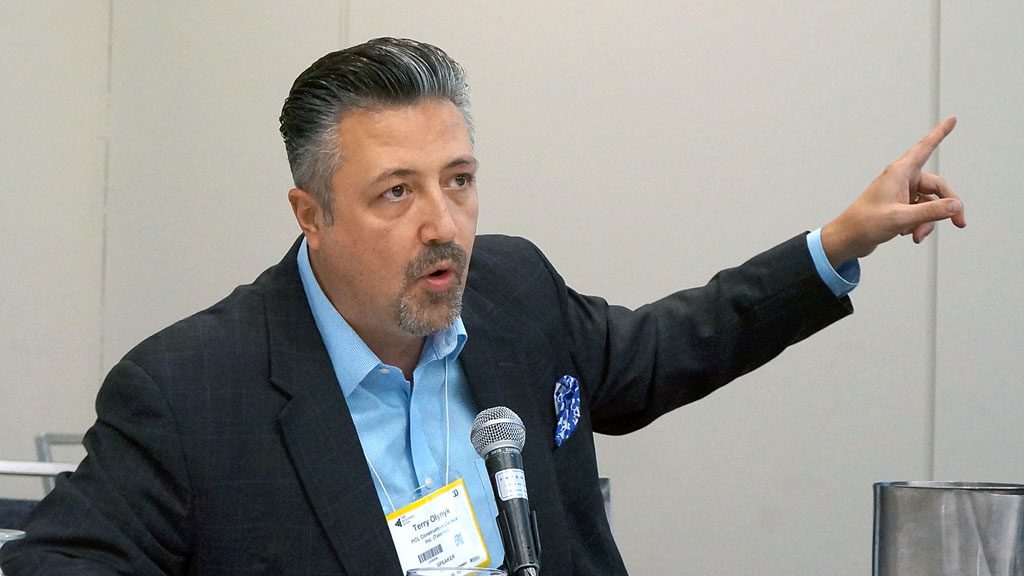For all those traditional construction companies that underestimate the importance of new technology, PCL Construction Canada’s Terry Olynyk has this advice: turn over a new leaf, if you want to grow in the next five years.
“I would probably appoint someone in your organization…to take stock of what technology you are utilizing and then go through a strategic planning session and challenge yourself on what you will look like in three years, five years down the road,” he said.
Olynyk, PCL’s director of business development, presented a seminar on Transforming the Construction Industry through the Internet of Things (IoT) recently at The Buildings Show in Toronto.
Contractors that don’t develop a digital strategy may be left behind.
“There will be one or two or three construction companies that get this right,” he told delegates, adding modularization is an example.
These contractors “are going to be able to achieve (the same production) with half the amount of people. It won’t be a level playing field anymore.”
PCL started seeing productivity challenges about five years ago as experienced workers neared retirement.
“When these people leave construction it is going to leave a huge void,” he said, noting young replacements won’t have the experience or skillsets of their predecessors.
PCL’s shift — which includes partnerships with a number of technology companies including Microsoft — will help reduce costs and project delivery times.
But persuading workers to use new technology isn’t always easy.
PCL hired a digital construction engineer who found many site personnel with access to such technologies as Bluebeam and BIM 360 Field did not use the software.
“It’s amazing how busy people are that they haven’t harnessed what is available to them today,” Olynyk said.
Consequently, young tech-minded people were trained to help others learn the technology available in-situ, rather than in boardrooms.
Olynyk said leaders in construction will be companies that harness a raft of technologies and embrace the IoT.
IoT is making a mark in post-construction applications as a platform to control buildings and it offers flexibility for changes in the future. But IoT is still new in construction settings.
“How are we using that technology to make construction smarter?”
Olynyk believes the idea of a digital twin — used when a BIM project is rendered in 3-D with enabled IoT sensors — will be a standard offering for all construction projects in five years.
How it works is that the information on a building’s construction is transferred to a digital twin that “completely represents what is happening in the built environment,” he said.
It allows users to “start to play with optimization strategies.”
Also important is for companies to future proof design and construction through innovation in materials and building components, he said. A glass product that goes beyond energy efficiency to make a building envelope an antenna for 5G connectivity is a case in point.
“It is incredible what is happening right now in the selection of material,” he explained.
Olynyk said optimizing opportunities for off-site prefabrication is paramount to success in the next few years.
“There have been buildings built modular (a decade or two ago) but we don’t know the painstaking effort they went through for alignment and accuracy and tolerance,” he added.
Computer modelling and laser scanning in the factory today, however, have been game changers in the shift to optimized modularization.
“It gives us confidence.”
There are other shifts in the industry that looked more like science fiction a few years ago. Olynyk pointed out PCL is using augmented reality technology for an $80-million baggage handling facility for the Greater Toronto Airports Authority.
“We have to nestle in a new facility over top of an existing (one). Through the augmented reality (our people) will be able to see where the future systems can be overlaid,” he said.
PCL is using MS HoloLens and SparkCognition.
PCL, which has more than 100 staff in its business technology and IT group focused on product development, believes sharing technology with the industry is important, Olynyk said.
“We can’t do this in isolation. I think it needs to be an industry change and we are willing to provide support.”



To survive and grow, intelligent GC’s will have to stay atune of new technologies in the IT/Automation sector for them and for their clients !!!